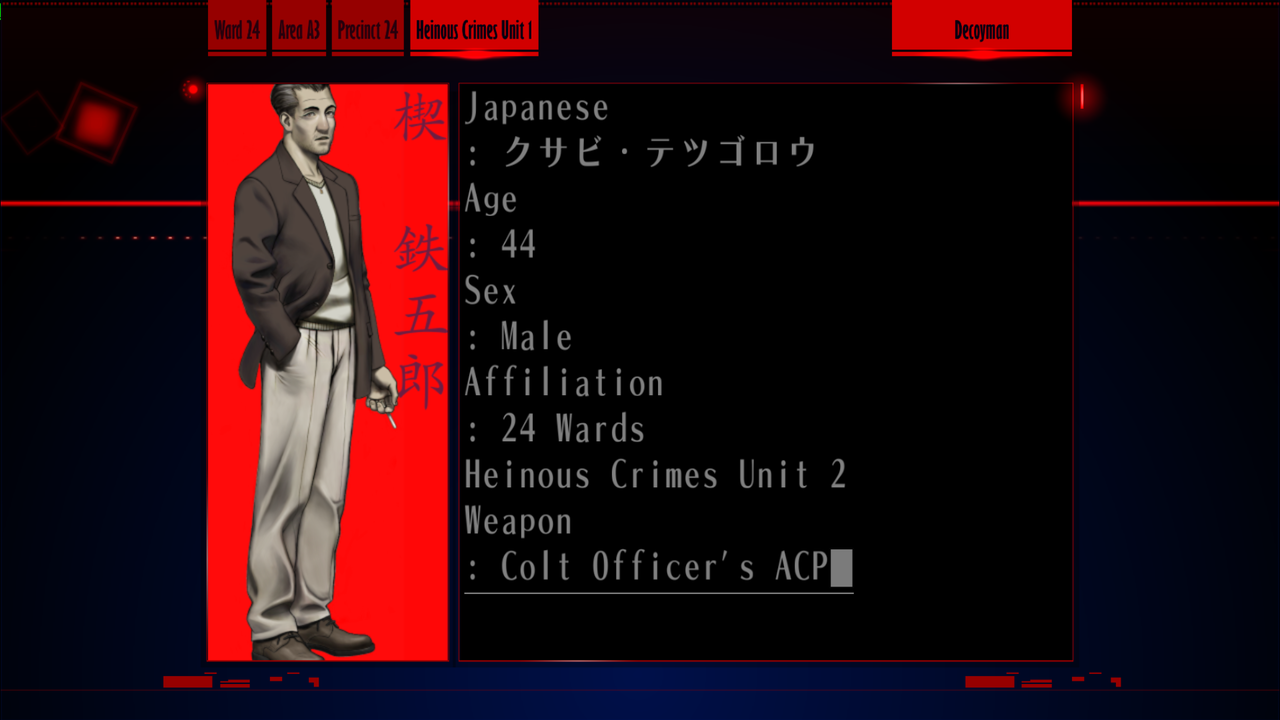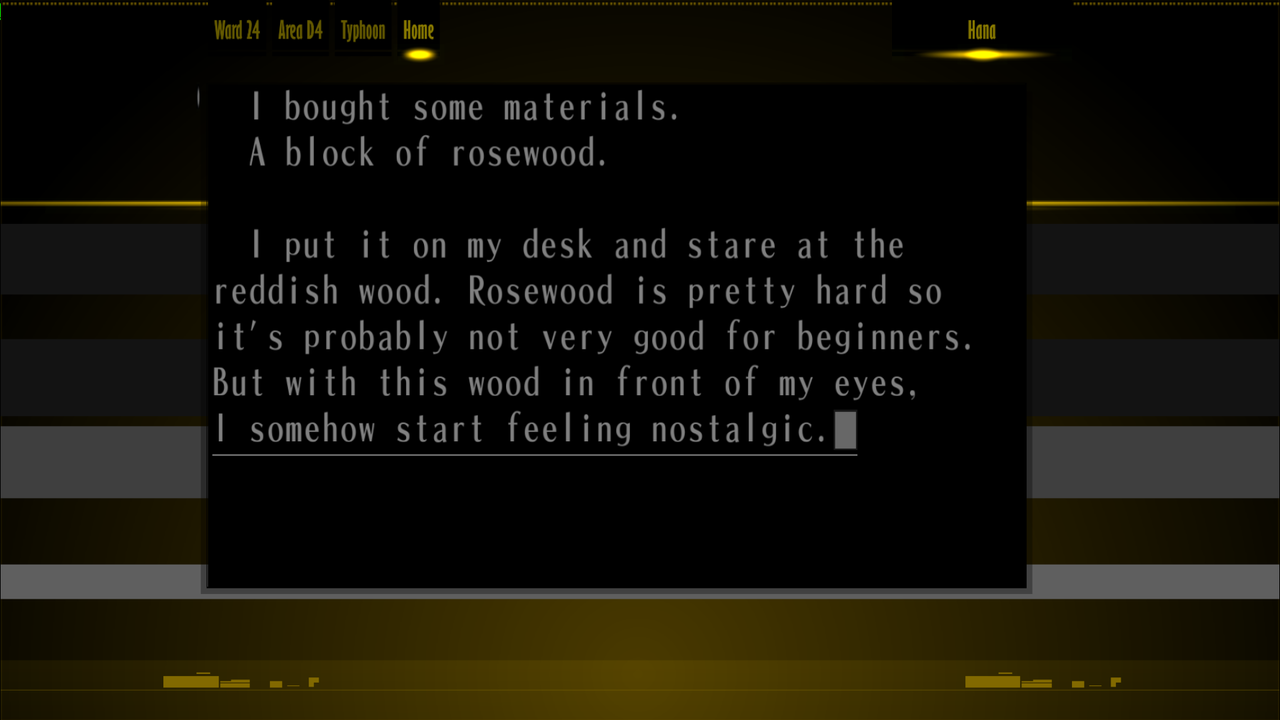Visual novels have never been a particularly attractive genre for me. Sure I've enjoyed the odd one here or there like Nine Hours, Nine Persons, Nine Doors but it's not a genre I seek out. However, when I saw The Silver Case on Steam and learned that it was the first game created by Suda 51’s studio, Grasshopper Manufacture, my interest was piqued. Originally released in 1999 on the PlayStation The Silver Case is a visual novel adventure game that is making its English debut in the full HD remake now available on Steam. It’s a sort of supernatural/conspiracy theory murder mystery.

You won’t have a lot of interaction with the visual novel story sections. The gameplay comes mainly from investigating key areas in the game, which play out more like a point and click adventure, albeit with no actual pointing or clicking. You use the arrow keys to move around, the ‘C ‘key to “contact” persons or objects adjacent to you and the ‘I’ key to utilize implements in your inventory. That last key isn't too important, as the objects in your inventory are only used at four points in the story as far as I can remember. There is the occasional puzzle but these too only make a handful of appearances. Most of your time will instead be spent walking around and talking to people.
These sections also betray The Silver Case’s origins as a PlayStation game despite its new HD coat of paint. The 3D environments look fine for what they are but there’s nothing in them as in the characters and objects you are interacting with aren’t there. Instead, in The Silver Case you move between set points that are marked by floating green triangles. If you see a floating star that indicates that there is something you can interact with adjacent to that point. When you stand in an area adjacent to something you can interact with there will be a green “contact point” graphic in the bottom of your screen. You get a list of things you can interact with from there and then select one from it. It’s strange getting used to pressing a key to discover that there is in fact supposed to be a person standing in front of me but I got used to it after a while.

Most of the areas you explore are multi-story buildings and switching floors triggers an animation that I would imagine was put in place to disguise the PlayStations loading times. More often than not, your points of focus will be on the bottom and top floors of a structure, a design decision that I can only assume was made to pad out the games running time. I understand the desire to break up the story and keep the player entertained, but these sections were extremely boring and they brought the story to a grinding halt rather than segmenting it as the designers intended. Overall, these sections were detrimental and The Silver Case would have been better if it was just a straight-up visual novel and added some choices to the dialogue for interactivity.
What the Silver Case lacks in gameplay, it makes up for with a stylish and well-told story, featuring just the occasional hiccup. Simply put, The Silver Case (much like Suda’s other work) is very weird and sometimes confusing. Most of the time the plot is confusing in order to obfuscate what is happening and then reveal the truth to you later but sometimes it tangles its web in a way that my brain can’t unravel at the pace the story wants to progress. There were a few times when I had to sit back and take inventory of what exactly was happening in order to catch up, and I wasn’t always able to complete the puzzle. By the end of the story I had a pretty good idea of what had transpired but even now there are a few lingering questions that I won’t go into too much detail on for fear of spoilers.
The translation of the game can also impede your understanding at certain points. For a native English speaker, the Japanese names of all the characters can run together at times. The characters all have distinct personalities so if I didn’t know who they were talking about I was able to infer it more often than not but there were several “Wait, who is that?” moments. A particular part of the translation that missed me is a scene where a character seemingly commits seppuku and I can’t understand for the life of me why. It got even weirder when said character appeared just fine in the very next scene. The music and overall tone of both scenes seemed to indicate that this was a joke of some kind but what exactly I’m supposed to find humorous is beyond me.

In spite of all this, I actually enjoyed The Silver Case quite a bit and it's a supremely engaging experience when the story comes together and everything clicks. The general structure of the story is that you acquire information as the detective in an investigation. Once that investigation is complete you switch playing as journalist Tokio Morishima and his chapter starts in the same timeframe as the beginning of the detective’s investigation. Throughout the chapter, you acquire more information and have generally caught up to the detective and by the end, you have some new piece of information or shocking revelation that the detective doesn’t before you go into the next investigation. This was what initially got The Silver Case’s hooks into me. The way the stories weave in and out and constantly leave you with cliffhangers as you and both the characters slowly start to piece together what is happening is enthralling and some of the most interesting murder mystery fiction I’ve experienced in a while.

Tokio's sections of the story feel much more immersive than the detectives, which is ironic since the detective has your name (or whatever obscenity you enter at the beginning of the game) and is silent for self-insertion purposes. The reason for this is that most of Tokio's story takes place in his apartment. You can check and send emails on his computer, make phone calls or talk with his pet turtle Red. He also keeps a memo where he records his thoughts on his computer so most of his story is told through browsing a computer. Because of this, I was able to get into Tokio's head much better than the main protagonist and he was far and away my favorite character in the game.
The art in The Silver Case is stylish and sleek. It pulls off the classic Asian cinema noir detective look perfectly with cigarettes, shady bars, and worn pistols. It also melds this style with a healthy dose of new millennium early internet websites and computers to create a compelling, and coherent art style. The visuals are presented in a comic book panel style and each chapter changes up the way the panels and window look to better suit the case. There is also an entire chapter that is black and white and it's gorgeous.

Ultimately The Silver Case tells a fascinating detective story in the way only Suda 51 could. Combine that with the fact that this is a visual novel and you should know right there whether you'll like it or not because this game is suited to a specific audience. However, if that does sound like something you can dig you just might love it.
The Silver Case was reviewed on PC via Steam with a code provided by the publisher. It is also available DRM-Free on GOG (Affiliate).
Review Summary
The Silver Case tells a fascinating murder mystery tale in a way only Suda 51 himself could. If you like visual novels give it a shot, but if you want good gameplay look elsewhere.
(Review Policy)Pros
- Stylish Noir Detective Story
- Great Characters
- Story Filled With Twists
Cons
- Little To No Focus On Gameplay
- Shows Its Age
Have a tip, or want to point out something we missed? Leave a Comment or e-mail us at tips@techraptor.net













